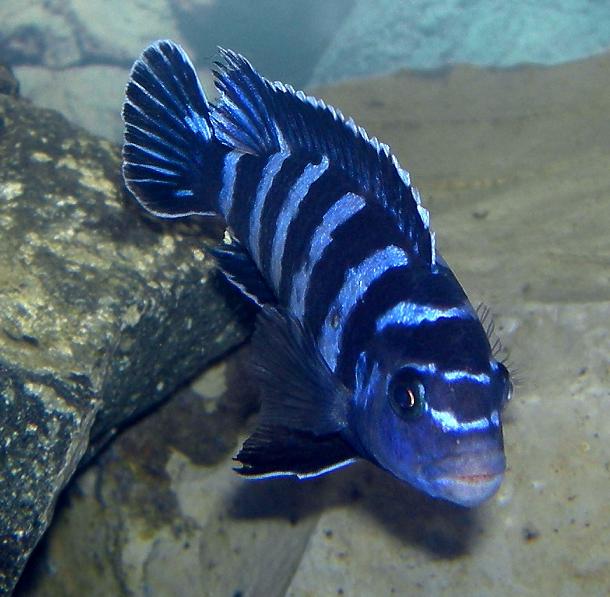 |
| Demasoni Cichlid - Photo by Lee Nachtigal |
Description
Demasoni is also known as the Midnight demasoni and is scientifically known as the Pseudotropheus demasoni from the cichlidae family. Its maximum length is 3 inches with a lifespan of 8 years. This species originated in Lake Malawi.
Both male and female of these species also come in the same color patterns unlike most fishes, only the male cichlid's color is brighter. The male possesses dark blue and black vertical stripes along its body and for some may have alternate blue or white stripes. The male will also display anal fin spots while the female does not. The female's color, however, is not as bright as the males.
Aquarium set-up
Demasoni cichlid needs to be in a community by the dozen or even more fishes to keep its aggression at a minimum level. Hence, these species require large size aquariums with capacious swimming space, as well as rocks and caves for hiding. Crevasses, rocks, and caves would satisfy its curiosity giving them adequate things and places to explore. It would also provide each demasoni a place to claim as its territory.
This diversity requires a temperature of 72 - 82 degrees Fahrenheit with a pH of 8.0 - 9.0 range and also a water hardness of 10 - 18 dH.
Behavior and Tank mates
Your demasoni can be deceiving because of its size. So be wary in incorporating tank mates in the community. What the size lacks are all compensated with its aggressiveness and hostility. These fishes are known to have the capacity to attack fishes twice as big as they are and can wipe out a whole community without difficulty.
Bear in mind that these species are really aggressive and brutal which should not be housed in a species tank. They are only compatible with aggressive fishes and must not be kept with other cichlids that look similar to its appearance or even other fishes with stripes.
Diet
Demasoni diet is more on a high vegetable matter and needs only a low protein intake. Meaty foods should be canceled in its diet instead cichlid sticks and flakes are more favorable to its diet. Spirulina foods may be given frequently.
Breeding
Spawning should be 3 females to 1 male to achieve optimum results. It is usually the female who will look for a flat rocky place on which to lay its eggs and then pick the eggs up to her mouth for brooding. She will then closely follow the male until he releases the sperm to fertilize the eggs she is carrying.
The eggs will be kept inside the female's mouth for about three weeks for incubation before it is released. The fry may then be fed with crushed flakes or pellets, daphnia, or a small brine shrimp.
Demasoni cichlid may be tough to handle due to its aggressiveness towards other tank mates but are still an amazing species to keep with its vivid and bright colors. Find out what are its best tank mates and how to control its aggressiveness, I'm pretty sure, you will love the sight of them in your house.
Article Directory: EzineArticles |

No comments:
Post a Comment